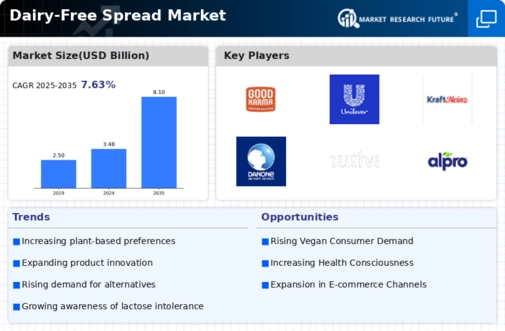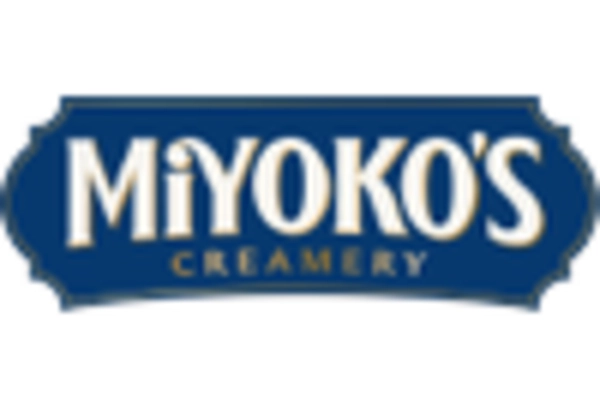The Dairy-Free Spread Market is currently characterized by a dynamic competitive landscape, driven by increasing consumer demand for plant-based alternatives and heightened awareness of health and sustainability. Major players such as Miyoko's Creamery (US), Earth Balance (US), and Violife (GR) are strategically positioning themselves through innovation and regional expansion. For instance, Miyoko's Creamery (US) has focused on premium, artisanal products that appeal to health-conscious consumers, while Earth Balance (US) emphasizes its commitment to non-GMO ingredients and sustainability. These strategies collectively enhance their market presence and influence consumer preferences, thereby shaping the competitive environment.
In terms of business tactics, companies are increasingly localizing manufacturing to reduce supply chain complexities and enhance responsiveness to regional market demands. The Dairy-Free Spread Market appears moderately fragmented, with several key players exerting significant influence. This structure allows for a diverse range of products, catering to various consumer preferences, while also fostering competition among established brands and emerging entrants.
In August 2025, Violife (GR) announced the launch of a new line of dairy-free spreads that utilize innovative fermentation technology to enhance flavor and texture. This strategic move not only positions Violife as a leader in product innovation but also aligns with the growing consumer trend towards more natural and minimally processed foods. The introduction of these products is likely to attract a broader customer base, further solidifying Violife's market share.
In September 2025, Earth Balance (US) expanded its distribution network by partnering with a major grocery chain to increase accessibility to its dairy-free spreads. This partnership is significant as it enhances brand visibility and allows Earth Balance to reach a wider audience, particularly in regions where plant-based options are still gaining traction. Such strategic alliances are crucial for maintaining competitive advantage in a rapidly evolving market.
In October 2025, Miyoko's Creamery (US) unveiled a new sustainability initiative aimed at reducing its carbon footprint through improved packaging solutions and sourcing practices. This initiative reflects a broader trend within the industry towards sustainability, which is increasingly becoming a key differentiator among brands. By prioritizing environmental responsibility, Miyoko's not only appeals to eco-conscious consumers but also positions itself favorably against competitors who may not be as proactive in this area.
As of October 2025, the Dairy-Free Spread Market is witnessing trends that emphasize digitalization, sustainability, and technological integration. Companies are leveraging digital platforms for marketing and consumer engagement, while sustainability initiatives are becoming integral to brand identity. Strategic alliances are shaping the competitive landscape, allowing companies to pool resources and expertise. Looking ahead, competitive differentiation is likely to evolve from traditional price-based competition to a focus on innovation, technology, and supply chain reliability, as brands strive to meet the growing expectations of discerning consumers.

















Leave a Comment